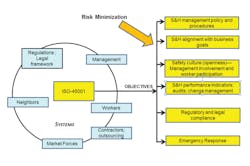ISO 45001 is a performance-based occupational health and safety management standard published on March 12, 2018. It is patterned after widely used management standards such as ISO 14001 and ISO 9001 and is applicable to many industries, including refining, chemicals and pharmaceuticals. Among the benefits of the standard are improved regulatory compliance, cost-effective risk management and improved commitment to safety by workers as well as managers.
ISO 45001 certification could also serve as a marketing tool to demonstrate your company’s commitment to safety and social responsibility. You will need to do a cost-benefit analysis to determine the value of ISO 45001 to your company.
ISO 45001 will replace the existing safety management standard OHSAS 18001 in three years. ISO 45001 puts top emphasis on worker participation and management involvement. It emphasizes safety programs and de-emphasizes prescriptive slant of safety and health procedures. Instead, emphasis is on performance. However, this does not mean that you abandon structured procedures which are vitally important for compliance with numerous prescriptive OSHA standards.
ISO 45001 takes a systems approach in determining safety requirements: workers, management, machines and processes, contractors, and neighbors are some of the key systems which interact with safety performance (see Figure 1).
There are ten major clauses:
Clause 1. Scope.
Clause 2. Normative References.
Clause 3. Terms and Definitions.
Clause 4. Context of the Organization. This clause considers internal and external issues which could affect the business and as a consequence, its safety management practices. In a broad sense, this clause combines the objectives of OSHA and the risk management plan. This clause requires that a company considers these factors in developing a safety management system. Some of the examples of this are multi-company sites, mergers/acquisitions, neighbors, employee turnover, and equipment or operational/maintenance changes.
Clause 5. Leadership. Key thrust of this clause is that top management should show greater involvement in EHS management. It elevates EHS management to the highest levels of management.
Clause 6. Planning. This cause is pervasive in the sense that it applies to almost all phases of your safety management system. A safety management system should be proactive in risk management as well as robust enough to respond to emergency situations.
Clause 7. Support systems. The ISO-45001 requires specific emphasis on infrastructure or resources required to achieve an organization’s safety objectives.
Clause 8. Operation. This clause is similar to the Management of Change (MOC) system.
Clause 9. Performance Evaluation. The standard takes a data-centric approach to managing safety. This is also called Key Performance Indicators—both leading and lagging indicators.
Clause 10. Improvement. This is similar to ISO quality standards. Intent is ongoing improvements.
SHOULD YOU CONSIDER ISO 45001 CERTIFICATION?
As you can see, this standard, like many other ISO standards, can be implemented to any organization or safety and health systems.
Qualitatively, benefits of ISO 45001 include effective management of risk and opportunities, improved safety culture and worker/management commitment, reduction in injuries and consequently insurance premiums, and improved public image of your company. Thus, internally ISO 45001 could be an effective tool for improving cost-effective safety, while externally it could open up significant marketing opportunities.
European governments are encouraging companies to become ISO 45001 certified. For companies doing business with these companies, certification could be beneficial. You need to do a cost-benefit assessment before applying this standard. Should you decide to implement this standard, consider the following:
• As may be expected, implementation for smaller, one-site organizations would be simpler compared to that for large, multi-site, or multi-employer organizations.
• Keep workers apprised of your broad objectives. Their buy-in is also vital for the long-term success.
• Evaluate each of the ISO 45001 clauses systemically: Internal systems such as operations, maintenance, procurement and other support systems. External systems such as contractors, public, regulations and competitors.
• Consider your existing safety management system and how you can adapt it to the ISO 45001 clauses. The migration or modification of the system should be gradual and should be seamless to users.
AVOID EXCESS BUREAUCRACY
ISO 45001 is a flexible set of requirements designed to manage risk. It is not procedure-based, but process based. Like any other system, excessive bureaucracy will severely diminish its effectiveness.

